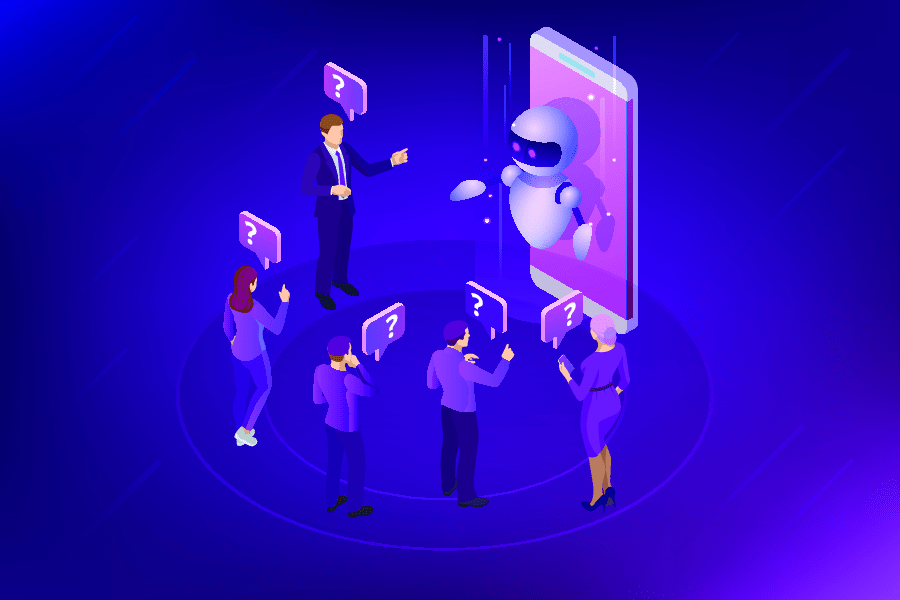In today’s competitive world, offering the finest customer experience is a priority for almost all companies. And clients are becoming more and more lenient towards getting efficient and real-time customer services. Chatbots happen to provide 24/7 customer care.
When clients contact customer services, they always prefer an instant response. Even for just basic inquiries. Providing customer services by humans, even though they are still preferred by some clients, is not always an ideal alternative to delivering instant assistance. Sometimes, they may even get discouraged from working under pressure. As a result, companies could lose clients due to unsatisfactory customer experiences. Chatbots, on the other hand, don’t bother to provide such services even under the most undesirable conditions.
A chatbot system employs conversational Artificial Intelligence (AI) technology to imitate a natural language dialogue with users using messaging platforms. Chatbots help users to obtain timely and efficient assistance by performing live chats, in response to real-time user interactions through rule-based language programs.
The Need for Adopting Chatbots
Almost every organization in the world pays serious attention to their customer satisfaction feedback. For that reason, these days, chatbots are widely used to provide instant customer assistance on most websites. Even though customer care services were entirely used to be handled by humans, nowadays they are mostly handled by chatbots, which always respond to customer inquiries quickly and efficiently.
In 2020, Forbes reported that 96 percent of clients would abandon a company due to poor customer service. Furthermore, according to Zendesk’s 2022 report, more than six out of 10 consumers say they would stop purchasing from a company and switch to a competitor after just one poor customer service experience.
As a result, most companies have invested in adopting chatbots into their platforms. According to a study conducted by Insider Intelligence, nearly 40 percent of global internet users prefer communicating with chatbots rather than with virtual agents, and with major industries such as retail and healthcare migrating their operations to digital technology, chatbots are set to become more popular in the future.
Trends in Chatbot Customer Experience
Ever since Microsoft launched a service that allows companies to create their own chatbots, by providing the tools that are required to automate administrative tasks via chatbots, several industries have adopted chatbots as their ideal customer service instrument. This is majorly due to their capability to reduce costs by cutting payroll expenditures. According to Insider Intelligence, the adoption of chatbots could save the healthcare, banking, and retail sectors $11 billion annually by 2023.
Since 2019, the adoption of chatbots by several industries has greatly influenced the entire customer care market. Based on a report by Fortune Business Insights, the global customer experience management market is valued at $11.34 billion in 2022. This represents a 12.2 percent increase from the previous year’s value of $10.11 billion, and it is expected to reach $32.53 billion by 2029. The market is expected to not only continue expanding but also to maintain its excellent growth rate in the next few years.
Features of Chatbots
Chatbots are powered by amazing features that make them the perfect tools for improving customer experience.
The most noticeable feature is that they are available 24/7. Any client can forward their inquiries at any time and is guaranteed an instant response with the simplest solution. Besides, conversations with chatbots progress with a smooth live chat, that mimics humans’ interactive dialogue. Hence, there is no need to wait for responses.
In addition, chatbots have a personalized interaction feature that enhances the communication between businesses and clients. This allows the chatbots to establish a bond with customers in order to win their loyalty. Besides, based on customers’ preference history, chatbots can gather customer feedback and forward it to the management team for decision-making on the shortcoming of services.
Moreover, most chatbots are integrated with a third-party application, which helps to assess customers’ preference habits to enhance their future experiences. Not only that, some chatbots are designed to help clients place their usual orders, report on the status of deliveries, remind them of their utility bills, and assist them with product purchases.
Furthermore, chatbots can provide multilingual conversations, which allows companies to reach to a wider range of nations while at the same time allowing clients to make their inquiries with minimal effort. On top of that, chatbots are programmed with excellent emotional intelligence, which allows clients to readily interact with company services through exciting dialogues.
Photo: Golden Sikorka/Shutterstock
You might also like:
Support us!
All your donations will be used to pay the magazine’s journalists and to support the ongoing costs of maintaining the site.
Share this post
Interested in co-operating with us?
We are open to co-operation from writers and businesses alike. You can reach us on our email at cooperations@youthtimemag.com/magazine@youthtimemag.com and we will get back to you as quick as we can.









